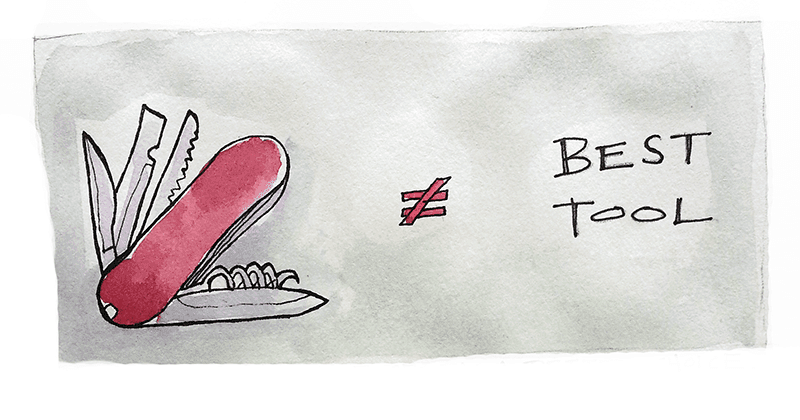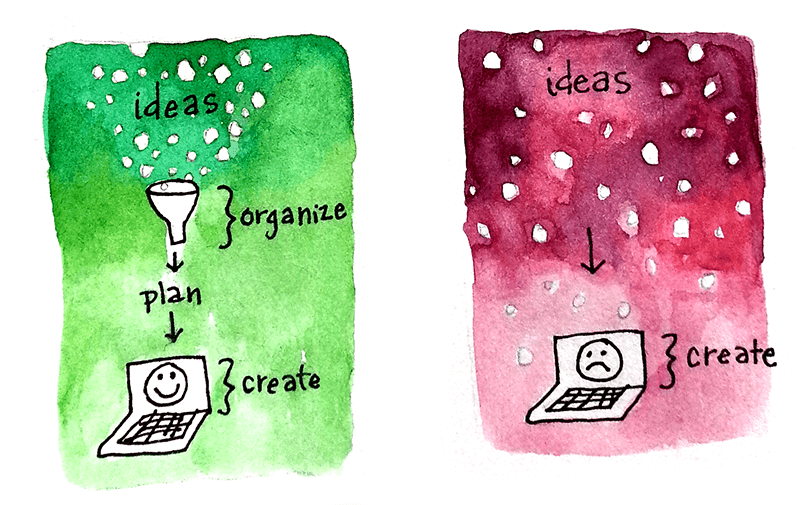How To Organize Your Writing Ideas For Your Blog
- An uncontrollable desire to sign up for every new organizational app that comes along. Fun to try, but impossible to manage them all.
- A regular use of unconnected systems, one for your work computer, one at home, and one on mobile devices. The differences in the apps affect what you prefer to use on the different platforms.
- A struggle to use products that do and don't integrate with other apps and find that perfect mix.
Create A System To Organize Your Ideas
Systems are tricky, and while I enjoy reading blog posts about the solutions others have come up with, I know that they won't work perfectly for me. We don't all work the same, and a perfect solution doesn't exist as a standard. What works for me won't make a bit of sense to you, in all likelihood. It really is up to you to figure out what will work, often through trial and error and considering the pros and cons of options available. What makes a good system? How do you decide what tools to use?
1. It must be simple.
Sometimes the simple tool is the better tool. The system you create can't be too complicated. If it is, you won't stick with it. I have a personal theory that seems to be true for me, at least, that if something takes more than three steps to use, I'm not likely to stick with it. I've seen many blog posts showing how you can use organizational apps such as Trello or Asana–both great organizational apps–as an editorial calendar, but by the time I'm done reading, I'm absolutely convinced I'd never use it. There are too many steps to make things happen (which, of course, is why we created CoSchedule). They are complicated and sometimes a bit hacked together. Hacking a tool is a fun challenge, but it isn't a solid foundation. I'd rather have a tool that I can use the way it is intended to get the job done. So, how do you keep things simple?- Understand the tools. Expecting an editorial calendar to control how your blog theme looks doesn't make much sense. That's not what the tool is for. While we all dream of the perfect all-in-one tool that does everything we need it to do in one place, remember that not everyone works the same and that such a tool cannot possibly exist. Understand
- Use tools as they were intended. Things tend to get complicated when we decide to go ahead and use a tool in a way that it wasn't intended. Tools tend to get complicated when they implement features and changes that don't fit in with their original core focus (feature creep). Don't use a spreadsheet when a database is what you need. Don't use a task management system as an editorial calendar.
- Restrict the number of tools you'll use. Refrain from signing up for every new, cool app that comes along. It's one thing to try it, but another to start moving all of your content into it only to decide that no, it doesn't really work.
- Choose well-made tools. Find a tool that does what you want it to do, not a tool loaded with unnecessary features that make things complicated. I used to use Springpad religiously, but they began updates that took it from being a handy notes app into something that seemed to resemble Pinterest. I didn't need those features, and I didn't like the bloat and complexity. I eventually just drifted away and found a different notes app.
- Control yourself. Your system for organizing blog post ideas is just for organizing blog post ideas. It is not an additional to-do list for things you have to do on your web site, and maybe a grocery list thrown in. A simple system that works for blog ideas might be something you can replicate for planning web site landing pages, but don't combine the two at the get go.
Complex systems inevitably break down. Organize your blog ideas simply.
Click To Tweet2. It must work like you work.
You have to know how you work which, surprisingly, some writers haven't taken the time to really consider. Do you work by free-writing a full draft post? Do you collect links and phrases and drop them into a repository, knowing you can build a full post off of it later? Do you need to collect images as inspiration or to use? Do you get your ideas while driving and prefer to record yourself talking? These kinds of questions will help you know which tool is going to be useful and which won't fit how you work. For example, I like Google Keep. It's a bare bones unfussy notes app and I use it. But I don't really use it for my blog or writing ideas. Why? Because sometimes I want to record ideas that come to me while driving and while Google Keep allows you to record, it stops when you stop talking, i.e. no pauses. Keep tries (not always so great) to transcribe the recording and create a note to go along the clip, but it makes playback on the web challenging. With Keep, it is better to play the note back using your phone. Now Evernote is a bit different. It starts recording and keeps going until you hit stop, and you can play it back from the web just fine which is handy for transcription. How do you work? Will the tool be fighting against you? Then don't use it.Are you using your planning tools, or fighting against them.
Click To Tweet3. It must work where you work.
Your system has to be usable wherever you'd likely use it. Where you write is about a physical space, sure, but also the publishing software you use. This means if you aren't ever going to write a blog post on your phone, then don't reject a solution just because it doesn't have a blogging app for your phone. Or, if you often write where there is not internet access, you'll need something that allows you to work (work, not just view) offline. Integrations are a big deal. If you are working in WordPress, does the tool you use integrate with WordPress, or are you having to rely on copy-and-paste techniques? Is the tool excellent enough that you are willing to use copy-and-paste techniques? Does the tool update your calendar if you're task-orientated? Where do you work? Will the tool function there? If it won't, it might not be the solution; it might just be a headache.The organization system that works for someone else likely won't be your perfect fit.
Click To Tweet4. The difference between planning and creating.
The perfect system for organizing your ideas has to acknowledge that planning and creating are not the same. The need to plan is why you must organize your ideas in the first place. The creating happens fairly easily if that organized planning happened. In your system, do you want your planning to happen where you write the actual content, or do you want to keep them separate? This is actually the most difficult and confusing question. Some people really want that all-in-one experience, and think that their method of idea organization is a failure because it doesn't morph easily into the final creation. As anyone with a headful (and a harddisk full) of ideas and research knows, creation is easy if you did your organization and planning right.Good organization of ideas is 90% of the battle of creating a blog post.
Click To Tweet
Putting It In Action
I know it is frustrating to read an open-ended blog post that says you must figure it out yourself (however true that might be). So, for those of you who prefer to read examples and have a prescribed "assignment", here you go.Simplicity: Your current habits.
First, outline your current habits. For example, I have an Android phone. I have a Chrome book. I use Google products intuitively throughout the day on my desktop, phone, and tablet. I've already built the habit of using Gmail as more than just email, and more for complete project management. Google integration and/or the availability of an Android app = simplification for me. My habits include Google products.How: Find current redundancies.
I heavily use CoSchedule to leave blog ideas, notes, and links with the specific post. I keep the app open in a tab and as I'm reading blogs or surfing the web, I grab links to relevant research, hop over to CoSchedule, and leave it in the comments section of the applicable post. Super easy, everything is tidy and right where it should be when it comes time to write. There are no redundancies. I am not stockpiling my ideas and notes in an outside app, then copying and pasting them later into WordPress (or even CoSchedule). They are stored right where I'll be working from later.Where: Your needed integrations.
There are a few must-haves that I make sure come into play somewhere in my idea organization system. I need WordPress integration somewhere along the line. I need to be sure the quick-grab notes are associated with an actual WordPress post, easily found.Examples: Systems of organizing ideas.
You've read reviews of tools, you've read this post, but you still want someone to give you a specific example of how you should organize your ideas for your blog. You're in luck! We have an outline for you.---
When it comes down to the struggle of having something to write on your blog, it's easy to confusing writer's block, an inability to get things done, or no ideas as the culprit. Most of us have ideas–lots of ideas, in fact–but just don't keep a tight reign on them. You've probably forgotten more great ideas of things to write about than you're aware of. Hopefully, this post helps you rethink what the real source of the problem is, and how to approach a true solution.

